The Best Water Bottles in Canada of 2022
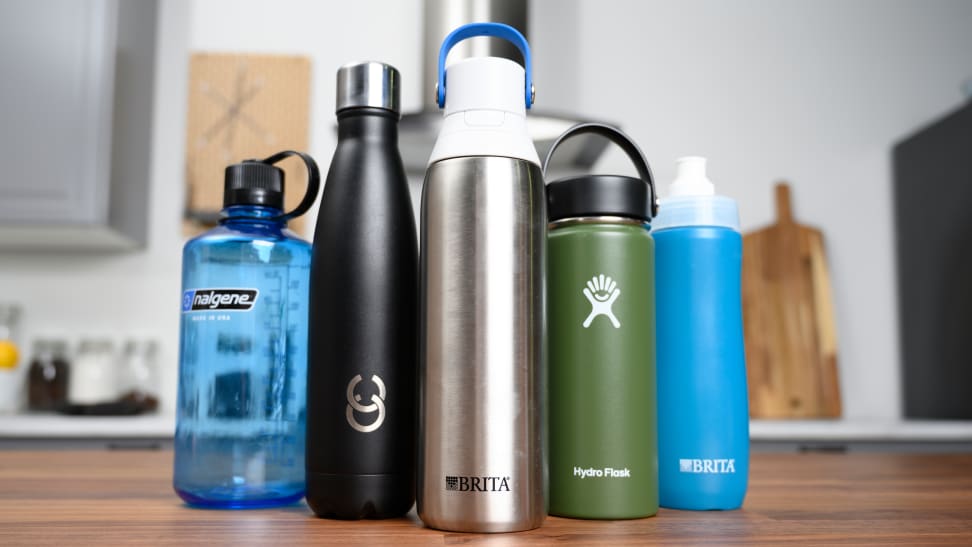 — Recommendations are independently chosen by Reviewed’s editors. Purchases you make through our links may earn us a commission.
— Recommendations are independently chosen by Reviewed’s editors. Purchases you make through our links may earn us a commission.Staying hydrated is an easy trick to help keep you healthy. By increasing your daily water intake, you'll be giving your brain what it needs to think more quickly. It often helps quell the urge to overeat, too. Feeling sore? Being well-hydrated will assist the rest of your body by lubricating your joints, helping to stave off inflammation. With perks like these achievable through little more than remembering to drink a little more water a little more often, it's hard to find to reason why you shouldn't have a reusable water bottle at your side.
After extensive testing, we found that the Brita Stainless Steel Filtering Water Bottle is the best water bottle for everyday life. We found this 20-ounce (591 ml) bottle kept the liquid inside refreshingly frosty. Additionally, the brand’s patented filter ensured that water straight-from-the-tap was tasty and chlorine-free. By keeping this great stainless steel bottle within your grasp, meeting your hydration goals will be a cinch.
These are the best water bottles we tested ranked, in order:
- Brita Stainless Steel Filtering
- Yeti Rambler 26-ounce Vacuum Insulated Stainless Steel Bottle with Cap
- Hydro Flask Double Wall Vacuum Insulated Stainless-Steel Leak Proof Sports Water Bottle
- Klean Kanteen Wide Insulated Stainless-Steel Bottle With Loop
- CamelBak Eddy
- Vapur Element
- Lifefactory BPA-Free Glass Water Bottle with Straw Cap and Silicone Sleeve
- Thermos Intak Hydration Bottle with Meter
- S’well Vacuum Insulated Stainless Steel Water Bottle
- Takeya Classic Glass Water Bottle with Silicone Sleeve and Twist Cap
- Klean Kanteen Insulated TKPro
- Brita Sport with Filter
- CrazyCap2
- Nalgene Silo Wide Mouth BPA-Free Water Bottle
- Memobottle A5
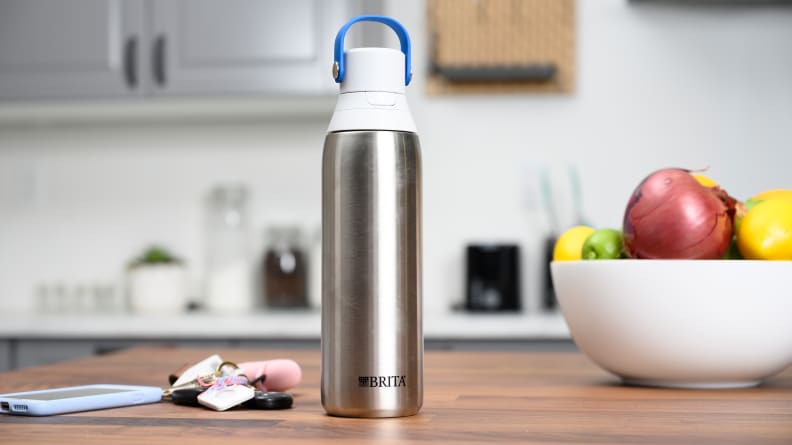

The best water bottle we've tested is the Brita Stainless Steel Filtering Water Bottle
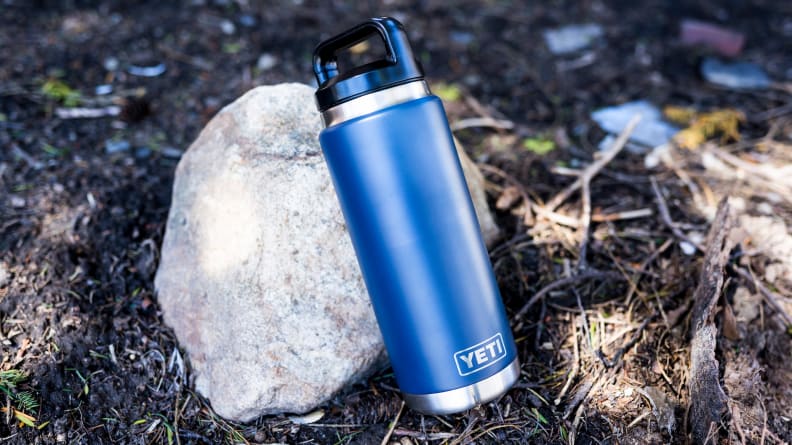

If you're looking for the best water bottle to take on a hike, we recommend the Yeti Rambler.
From a company well known for the durability and insulation of its coolers, sporting gear, and apparel, there’s a reason the impenetrable Yeti Rambler scores top marks for premier water bottles amongst outdoor enthusiasts. The reusable water bottle topped all the tests we threw at it, placing it as a serious contender for the best water bottle.
This insulated water bottle is made from kitchen-grade stainless steel that’s puncture, dent, and rust-resistant. And it has a simple, cylindrical design free of unnecessary small parts, that are liable to get lost or break off (the cap even has magnetic docks, which keep it securely attached to the lid). Double-walled insulation keeps the outside from getting hot or cold to the touch, or slippery with condensation, and allowed it to hold its own during temperature tests. Whether left in a hot car or kept on a bedside table overnight, water stored in the Rambler remained icicle cold; a good indicator of its usefulness during hiking or camping trips.
A leak-proof, easy to grip, three-finger cap adds to its outdoor appeal, as does a generous, 26-ounce (769 ml) capacity—enough to accommodate three lemonades, four mint juleps, or one long chug of water, according to the company. It also has an especially wide mouth, which facilitates sipping and cleaning (if you’re not trekking through forests and fields, it’s also dishwasher safe).
On the other hand, the factors that make the Rambler ideal for sporty activities knock it down a peg in terms of everyday use, which is why we didn't name this our best overall. The large size and robust materials make it undeniably heavy, quite bulky, not easy to hold, and difficult to slip in car holders or bags (although Yeti makes smaller options that might be a bit easier to handle).
Pros
-
Double-wall insulation
-
Easy to Grip
-
Wide mouth
Cons
-
Heavy
-
Difficult to slip in car holders or bags
How We Tested
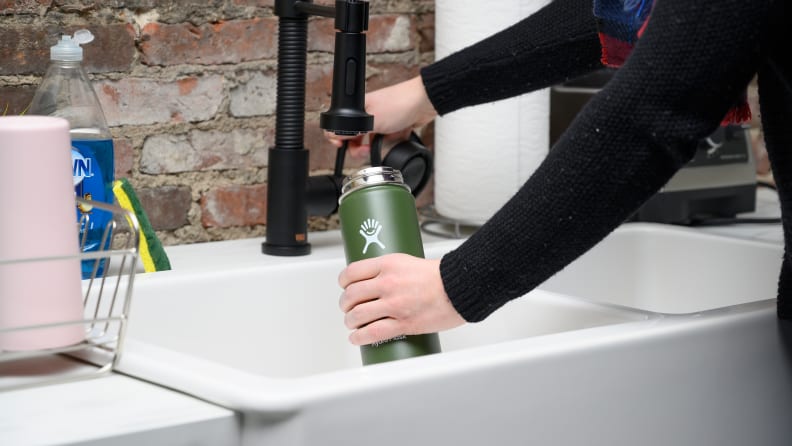
The subjective data we captured was just as valuable as our scientific test results.
The Tester
My name is Sarah Zorn, and I’m a professional food writer. And frankly, my only healthy lifestyle choice is that I drink lots and lots and lots of water. I generally have some on hand, whether I’m tapping away at my computer, testing recipes in the kitchen, on my way to a meeting, or walking my dog. And by keeping my water both accessible and chilled, the almighty bottle makes a big difference in my day.
The Tests
To find the best water bottles, we first measured how long they kept their contents chilled over time; filling them with ice cubes and water, and checking their temperature after one and five hours. We also determined if the bottle materials transmitted any “off” flavors to the water, after sitting for long periods. Finally, we assessed ease of use based on numerous factors, such as, how easy the bottles were to open and close, how portable they were, how painless they were to clean, and if they had any special features that we found especially helpful (or even remotely functional).
Why Bother with a Reusable Water Bottle?
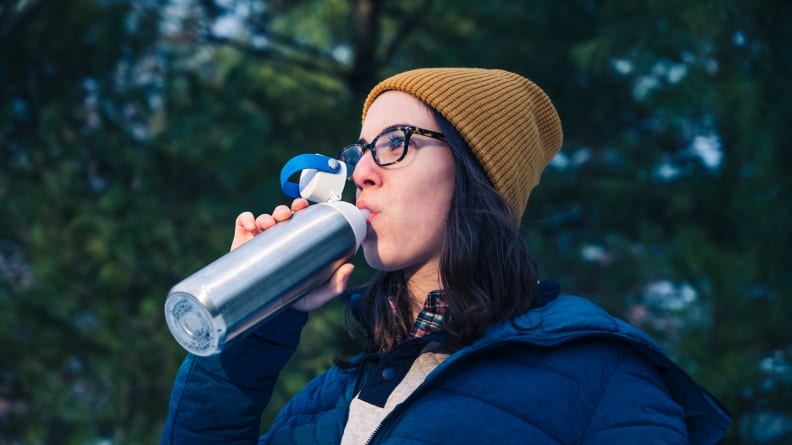
There are so many excellent reasons to invest in a reusable water bottle.
For starters, only one in five of every disposable made wind up in recycling centers. Given that it can take some types of plastic between 450 to 1,000 years for to completely break down (worse than this, bottles made using Polyethylene Terephthalate won't biodegrade, at all,) that makes for a whole lot of discarded drinking vessels cluttering up our planet. Add to this the fact that over 1.5 million barrels of oil per year are used in the production of plastic water bottles and the quench to quell your thirst with a container of water acquired at a corner store becomes a quagmire of massive environmental issues.
It used to be that schools, offices, and public spaces were ripe with water fountains that you could drink from. However, as the money required to keep pipes and fountain fixtures working as they should have trickled away and, as we've come to understand more about how viruses and other bugs are transmitted from person to person, these fixtures have fallen out of favour with health officials and civic planners.
In light of these issues, investing in a reusable water bottle to keep your drinks cold is one of the smartest choices you can make.
Are Plastic Or Glass Water Bottles Best?
From the type of material to the style of the cap, the best water bottles can be customized to suit your specific needs. Vacuum insulated stainless steel is almost unbeatable when it comes to keeping cool, but it is prone to denting if dropped and can leave a metallic taste. Plastic—look for BPA free —is lightweight, sturdy, inexpensive, and easy to clean, which is why it’s a go-to pick for athletes instead of glass bottles. But it’s not insulated and can give off-flavours and smells. Glass water bottles don't transmit off-tastes or odours (and may appeal to aesthetes), but it’s definitely heavier, costlier, and more fragile, making it less than ideal when it comes to portability/durability.
You’ll also want to consider quick access versus screw caps. Push/pull designs can be simply flicked up with one hand, and actually provide some sort of straw or spout lid to drink from. The other type needs to be actively undone with two hands, but is less prone to breaking, and is easier to disinfect and clean.
How Do I Clean My Water Bottle?
If you're constantly draining and refilling your water bottle, you might think that there's no reason to wash it on a regular basis: filling it up is as good as a rinse, right?
Actually, not so much. Bacteria loves moisture, even if you're rinsing and refilling your bottle three or four times a day, sooner or later, it's going to need a good wash. We recommend doing it once every 24 hours.
If you own a dishwasher, pop your bottle in the bottom or top rack and let the cleansing begin—but first, be sure to check that your bottle is dishwasher-safe. Most manufacturers tend to place this information on the bottom of the bottle. If it's not listed there, check the manufacturer's website for the data. Whether it's dishwasher safe or not, all water bottles, be they made of glass, plastic, or stainless steel, can be washed in a sink full of hot, soapy water.
To sink wash your water bottle, start by draining your bottle of whatever is left inside of it. Next, leave the cap in your dishwater to soak (giving the water a chance to loosen up any crud that may have collected in the grooves inside of the lid,) and scrub out the interior of the bottle using a bottle brush, like these ones. Now rinse the bottle in clean water and leave it out to air dry before turning your attention to the bottle's cap. Using your bottle Brush, scrub the cap, inside and out before drying it off.
If you just got over the flu or a cold, or your bottle was used to carry non-potable water, you may want to consider disinfecting your water bottle with a weak bleach solution. To make the solution, add a tablespoon of chlorine bleach to a quart of water. Dunk your water bottle and its lid in the solution and leave them to sit for five minutes--maybe use the time to make a sandwich or something. At the end of the five minutes, rinse your bottle with fresh water, dry it and you're ready to chug fluids, once again.
Other Water Bottles We Tested

There’s a reason Hydro Flask has so many fans; it’s portable, versatile, durable, and well designed. Its patented double-wall vacuum enables the bottle to keep cold drinks cold, hot drinks hot, and prevents condensation from forming on the outside, keeping it slip-free, and safe to store in bags alongside papers and laptops.
What we especially liked about this model is the wider mouth, which is easy to drink from and allows you to cram it with ice cubes. And if you want to make sipping more streamlined, you have the option to fit it with a straw or flip-top lid. Another benefit is that it fits many third-party water filters. That said, while it’s often a caveat with stainless steel, the bottle didn’t transmit any funky flavours to our drinking water.
Pros
-
Well insulated
-
Fits many third-party filters
-
Prevents condensation
Cons
-
None that we could find

Klean Kanteen’s Climate Lock insulation keeps water cold for up to two days (extra credit: it can be used for hot beverages, too). A powder coat guards against slipperiness and condensation, and like the Hydro Flask, the Kanteen can fit different in-brand caps, from the leak-proof loop cap, which can be hooked on a bag with a D-ring, to the quick-twist cafe cap, allowing it to become a casual to-go mug.
Pros
-
Keeps water cold for two days
-
Coating guards against condensation
Cons
-
None that we could find

Tired of tipping your water bottle at awkward angles in order to take a sip? The sporty, durable CamelBak Eddy was designed with that recurring issue in mind and comes equipped with a straw you can flip with one hand, as well as a bite valve that provides faster flow. It has decent temperature retention for a plastic bottle, is dishwasher safe, and comes with a lifetime guarantee, making it a cost-effective purchase. It’s forged from BPA-free materials, which is always a positive, and though we detected a slight flavour in the water, it wasn’t overtly present or offensive.
Pros
-
Built-in leak-proof straw
-
Dishwasher safe
-
Decent temperature retention
Cons
-
Slight plasticky flavor

This collapsible bottle is all about portability. Made from dishwasher-safe BPA-free 3-ply material, it’s both foldable and flexible. And though the mouth isn’t big enough to take in ice cubes, it can be filled with water, frozen, and used throughout the day, or rolled up and stashed. Since it’s not rigid, however, it’s not exactly meant to be propped on a desk, and since there’s no guard against condensation (and being that it’s essentially an ice pack), we’d be wary of storing it with anything you’d hate to get wet.
Pros
-
Extremely easy to roll up and store
-
Dishwasher safe
Cons
-
Condensation is a big problem
-
Doesn't stand upright well
-
Smaller mouth can't accommodate ice cubes well

As is the benefit of glass, water placed in the Lifefactory stayed odour- and flavour-free. Although there’s little in the way of insulation, so don’t bank on it staying chilled long-term. Still, a wide mouth makes it easy to add ice cubes as needed, and a protective silicone sleeve shields your hands against the cold. It also helps with gripping and presents a decent safety net in case the bottle drops. All materials are BPA, BPS and phthalate-free, FDA approved and dishwasher safe, but keep in mind, the glass makes for a heavier than average bottle.
Pros
-
Glass bottle prevents flavor leaching
-
Wide mouth fits ice cubes well
-
Dishwasher safe
Cons
-
Loses its cold quickly
-
Slightly heavy

Want to keep track of your water consumption? The venerable Thermos has integrated a rotating meter into the lid of their bottle, which is surprisingly modern and sexy for such an old-school brand. Not only is it comfortable to hold and easy to slip in bags and cup holders (thanks to an ergonomically designed body), and second nature to use (owing to a one-handed push up lid, locking ring and carry loop), it’s also quite a looker, courtesy of impact-resistant co-polyester, in a dark blue, smoke or magenta finish. Knocks against it are that the water warmed to room temperature after about an hour, and had a faint taste.
Pros
-
Includes a water intake meter
-
Easy to hold
-
Impact-resistant
Cons
-
Doesn't stay cold for long
-
Slight plasticky taste

The slim and streamlined S’well has triple-walled construction—it did a solid job of keeping our beverages cold (and the ability to keep hot beverages hot), even though we were only able to squeeze a few ice chips through the too-narrow mouth. The copper layer helps eliminate condensation, and the trim shape lets it fit seamlessly into cup holders and bags. It only comes with a twist cap, however, making it less than ideal for athletic use, and imparts a slight taste. But do-gooders will appreciate S’well’s partnerships with charities, such as American Forests, Breast Cancer Research Foundation, and UNICEF.
Pros
-
Does a great job of insulating
-
Water doesn't condense outside the bottle
-
Company partners with charities
Cons
-
Mouth is too small for ice cubes
-
Bottle is slick, not ideal for intense workouts

If you’re wary of potential toxic leaching from plastics, the lead-free Takeya is a solid option. It’s affordable and surprisingly portable, considering it’s made from weighty glass. Its silicone sleeve offers protection against drips, slips, and drops. However, the water warmed quickly, even though the mouth accommodates standard ice cubes, and you can’t manipulate the cap one-handed, due to its twist-off top.
Pros
-
Glass bottle prevents flavor leaching
-
Silicone sleeve prevents breakage
-
Ice cubes can fit in the mouth
Cons
-
No temperature insulation
-
Two hands needed to twist the top off

There are certainly upsides to this impenetrable Kanteen, including superior insulation, a chip-resistant finish, a complete absence of plastic parts, and a stainless steel cap that doubles as a cup. But our primary problems with this pricey bottle was that it just felt way too bulky for everyday use. It also took some doing to unscrew the two-part cap, and the small mouth wasn’t all that easy to fill with ice cubes.
Pros
-
Superior insulation
-
Chip resistant finish
Cons
-
Bulky
-
Hard to fill with ice cubes

While (even BPA free) plastic can occasionally leach flavours and odours into drinking water, Brita’s in-bottle filter is a bulwark against that. And even when factoring in the cost of replacement filters, this environmentally-conscious option is wallet-friendly as well, as one filter stands in for approximately 300 disposable water bottles—or up to 40 gallons (151 litres) of water—and only requires swapping out once every two months. The Brita’s soft squeeze body and leak-proof easy sip sports top also make it great for using while biking, hiking, or any outdoor activity.
Pros
-
Filters mean fresh, flavorless water
-
Soft body is easy to squeeze
-
Lid is leakproof
Cons
-
Cost of replacement filters can add up

Got money to burn? CrazyCap purports to be the next big thing in portable water filtration. A chargeable cap uses UV light to make water from any source drinkable. Tap the sensor twice for Normal Mode sterilization (from taps and public fountains), or five times for Crazy Mode Sterilization (water from lakes and ponds). It’s intriguing technology, and definitely has its place...while a basic Brita should be enough to take on taps and fountains, it’s a worthy purchase for campers, hikers, or travellers to areas with water impurities.
The fact the cap needs to be charged for hours, however (even though the charge lasts for 7 days), has the potential to hamstring people in situations/areas where water portability is an issue. And the water needs to be transparent and free of debris in order for the light to penetrate, which seems like a difficult ask if we’re talking about lakes and ponds.
Pros
-
Cutting edge design
-
Can cure water impurities
-
Long-lasting charge
Cons
-
Challenging to work

If more is more to you when it comes to water, you can’t beat the large capacity Nalgene, which holds 48 ounces (1420 ml) inside of its BPA-free, volume graduation-marked body, with an extra-large mouth for cramming in cubes. But you’ll be lugging around some serious weight and bulk; one that doesn’t fit into your standard cup holder. And besides sheer size, there are no other special features of note: Our water warmed almost instantly, and the twist-off cap with flimsy plastic loop make it a pain to carry, and not exactly effortless to use.
Pros
-
Holds 48oz
-
Wide mouth accommodates ice cubes well
Cons
-
Rapidly lost its cool
-
Heavy and bulky
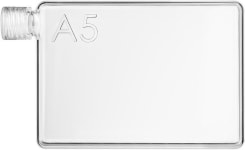
Snugly packaged in a slick, black box, and looking like a flat, plastic flask, the Memobottle is definitely the most eye-popping option on the list. Made from durable, BPA-free plastic, it’s designed to unobtrusively slip into briefcases or laptop bags and takes up a minimum of space in just about any carrying case. Aesthetics aside, though, it doesn’t stand on end, so you have to set it flat.
Also, the rectangular shape is rather awkward to hold. The tiny mouth doesn’t fit cubes or even crushed ice, so the only option is to refrigerate or freeze the bottle. But the sealant disc came loose from the inside of the cap when we tried it. And since there’s no protection against condensation, the frosted bottle will undoubtedly seep—if not leak—on whatever it comes into contact with.
Pros
-
Unique, slim design
-
Made from durable, BPA-free plastic
Cons
-
Awkward to handle
-
Can't put ice cubes in to chill beverages
-
No condensation protection
